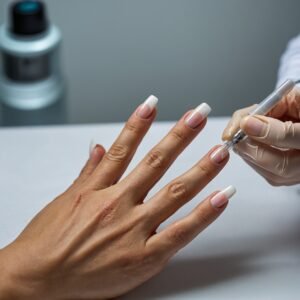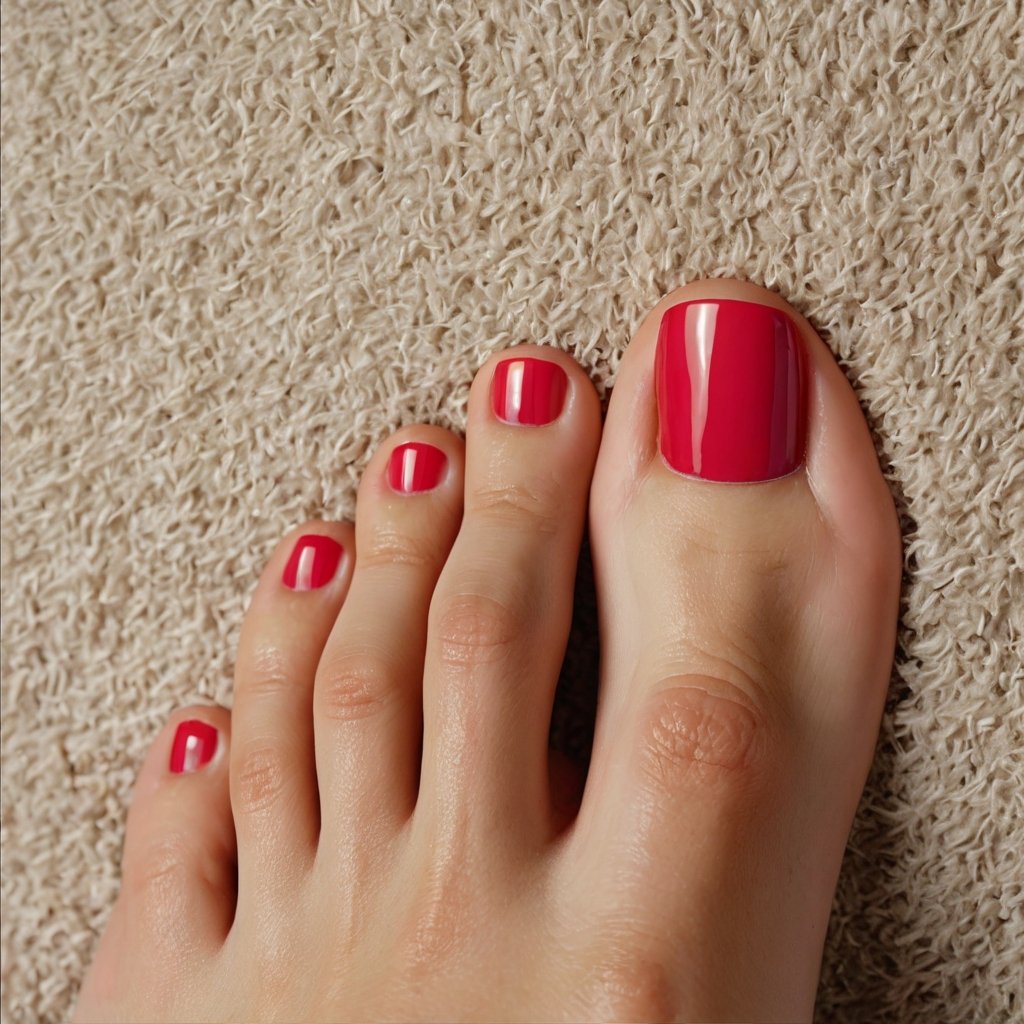How Long Does It Take for Nails to Grow 1 Centimeter? Everything You Need to Know
Nails grow about 0.1 mm per day, so it takes around 100 days (or roughly 3 to 4 months) for nails to grow 1 centimeter.
Nails are a fascinating part of our body, serving functional and aesthetic purposes. Whether fingernails or toenails, their growth, health, and care give us valuable insight into our overall well-being.
In this blog, we’ll explore nail growth, the factors influencing it, and ways to maintain a healthy nail.

Introduction to Nail Growth
Nails are made of keratin, a tough protein also found in hair and the outer layers of skin. They protect the tips of our fingers and toes while helping us with fine motor skills. Nails are made up of several essential parts:
Nail Matrix: The hidden root beneath the cuticle, responsible for nail growth. The cells in the matrix multiply and harden, forming the nail plate.
Nail Plate: The hard, visible surface of the nail.
Nail Bed: The skin beneath the nail plate contains blood vessels that provide the nutrients needed for nail growth. The nail bed is crucial for healthy nail growth. A strong nail bed supports your nails and helps them grow properly. Take care of your nail bed to avoid issues like thinning or infection. Keep your nail bed moisturized and healthy for the best results.
Cuticle: A thin layer of dead skin that protects the matrix.
Lunula: The half-moon shape at the nail’s base, marking the matrix’s visible part.
Nails grow because the constant production of nail cells in the matrix pushes older cells outward. Understanding this process is key to recognizing medical conditions and maintaining nail health.
Average Nail Growth Rates
The average growth rate of nails can vary due to different factors:
Fingernails typically grow about 3.5 millimeters per month or roughly 0.1 millimeters per day. While this growth rate might seem slow, it ensures steady nail renewal.
Toenails grow at a slower pace, around 1.6 millimeters per month.
Growth rates vary from person to person, depending on age, gender, and overall health.
Generally, men experience faster nail growth than women, although hormonal changes during pregnancy can speed up growth for women.
Age is also an essential factor:
Children’s nails grow faster due to their higher metabolic rate and better blood circulation.
As people age, nail growth often slows, with nails becoming more brittle or developing ridges.

Factors Influencing Nail Growth
Nail growth is influenced by both internal and external factors:
Internal Factors :
Age: Younger individuals have faster-growing nails due to active nail cells.
Hormonal Changes: Growth can be enhanced during pregnancy or puberty while aging generally slows it.
Hereditary Factors: Your genetics can affect nail shape, strength, and the rate of growth.
External Factors :
Climate: During summer months, when blood circulation is improved, nails tend to grow faster.
Physical Activity: Exercise can enhance blood circulation, which promotes nail growth.
Nutrition: A balanced diet is essential for nail health:
Protein is crucial for keratin formation.
Biotin, Zinc, and Vitamins A, C, and E help promote strong nails and reduce brittleness.

Differences Between Fingernails and Toenails
There are notable differences between fingernails and toenails:
Growth Rate: Fingernails grow about three times faster than toenails due to better blood circulation and more frequent use.
Thickness: Toenails are thicker and tend to grow more slowly. They are also more susceptible to fungal infections.
Injuries: Fingernails typically heal within six months, but toenails can take 12-18 months to fully regrow after an injury.
Tips to Promote Healthy Nail Growth
To support healthy nail growth, consider these tips:
Nutrition: Incorporate biotin (found in nuts and eggs), zinc (from seafood), and protein into your diet.
Moisturizing: Use cuticle oils or creams to prevent dryness.
Proper Trimming: Cut nails straight across to avoid ingrown nails and file them gently to prevent damage.
Avoid biting your nails: Avoid this healthy growth. When you avoid biting your nails, you prevent damage and allow them to grow stronger. Simply put, avoid biting your nails for the best results.
Avoid Damage: Avoid nail biting, as it weakens the nail matrix, and minimize using artificial nails. Products like bitter-tasting nail polish can help deter nail biting and protect nails from damage.

Common Myths About Nail Growth
Let’s address some common myths:
Trimming makes nails grow faster: False. While trimming prevents breakage, it doesn’t directly affect the rate of growth.
Nails grow after death: False. This myth occurs because skin shrinks after death, exposing more of the nail.
Expensive nail products guarantee faster growth, but not necessarily. Proper diet and blood circulation have a much more significant impact on growth.
Recognizing Signs of Unhealthy Nails
Your nails can give you clues about your overall health. Here are some warning signs to watch for:
Yellow Nails: Often caused by smoking, fungal infections, or lung disease.
Bluish Nails: These may indicate low oxygen levels in the blood, often linked to heart disease.
White Nails: These can be a sign of liver disease or malnutrition.
Brittle Nails: Associated with thyroid disorders or frequent water exposure.
When to Consult a Healthcare Professional
Seek medical attention if you experience:
Chronic nail infections that don’t respond to over-the-counter treatments.
Persistent pain, swelling, or discoloration.
Signs of systemic conditions such as arthritis, cardio-pulmonary diseases, or autoimmune diseases.
The Role of Genetics in Nail Growth
Hereditary factors can have a significant impact on nail growth:
Certain conditions, like spoon nails or yellow nail syndrome, are passed down through families.
Nail shape and strength often follow genetic patterns.
Impact of Lifestyle Choices on Nail Growth
Your habits can influence nail health:
Smoking can slow growth and cause discoloration.
Stress can reduce growth rates by increasing cortisol levels.
Regular exercise promotes blood circulation, supporting faster growth.
Environmental Factors Affecting Nail Growth
Environmental factors can either help or hinder nail growth:
Sunlight in the summer months boosts Vitamin D, which helps strengthen nails.
Excessive water exposure can cause nails to weaken and split.
Pollution and toxins can damage nails over time.
Nail Growth and Aging
As we age:
Nail growth slows, and nails may become brittle or ridged.
Common problems include fungal infections and thickened toenails.
Proper care, like moisturizing and trimming, can help reduce these issues.
Medical Treatments and Their Effects on Nails
Specific treatments affect nail health:
Chemotherapy can cause nails to become brittle or discolored.
Depending on the severity, recovery from nail injuries or surgeries can take months.

Diet and Nail Health
What you eat can directly affect how your nails grow. Protein is key because nails are made of keratin, a protein. Foods like chicken, eggs, fish, and beans are great sources of protein for stronger nails.
Biotin, found in nuts, seeds, and eggs, helps with nail growth. Zinc, which can be found in shellfish, meat, and beans, supports tissue repair and healthy nails.
Iron-rich foods like spinach, red meat, and lentils help prevent brittle nails.
For your nails to grow well, it’s important to have a balanced diet and avoid poor eating habits that might cause nutrient deficiencies. Not getting enough nutrients can slow nail growth and cause problems like discoloration, splitting, or brittleness.
Hydration and Nail Care
Staying hydrated is essential for healthy nails. Dry nails are more likely to crack, split, or break.
Regularly moisturizing your cuticles and nail bed helps keep your nails hydrated. If you live in a dry climate or wash your hands a lot, use cuticle oils or moisturizing creams to keep them healthy.
Drinking plenty of water is also important to hydrate your nails from the inside.
Physical Activity and Circulation
Exercise helps with blood circulation, which is important for nail growth. When you work out, blood flow to your fingers and toes increases, delivering the nutrients your nails need to grow. Exercise also reduces stress, which can affect blood flow and slow nail growth.
Nail Care Tips for Healthy Growth
To encourage healthy nail growth, it’s important to take care of your nails.
Avoid biting your nails because it can damage the nail bed and slow growth. Moisturize your nails and cuticles regularly to keep them hydrated.
Trim your nails regularly to avoid breakage and keep them in good shape.
If you use nail polish, make sure to give your nails a break in between applications so they don’t weaken from chemicals. Instead of cutting your nails, use a gentle nail file to prevent damage to the nail bed.
Special Nail Care During Pregnancy
Hormonal changes during pregnancy may speed up nail growth but can also lead to brittle nails. Stick to safe, non-toxic nail care products.
Supplements and Nail Growth
Supplements like biotin and collagen can help improve nail strength. However, they take time (several months) to show results and should be a part of a balanced diet.
Cultural Beliefs and Nail Growth
Cultural traditions emphasize nail care, such as using natural herb oils or herbal remedies.
Nail Growth in Children vs. Adults
Children’s nails tend to grow faster because of their higher metabolic activity. To avoid ingrown nails, make sure to trim and care for nails properly.
Nail Growth and Diet Trends
Unbalanced diets can lead to deficiencies that slow down growth. Ensure you’re getting a variety of nutrients to promote healthy nails.
Professional Treatments to Boost Nail Health
Regular manicures and pedicures can improve nail hygiene and aesthetics. Avoid overusing artificial nails, as they can weaken natural nails.
Fun Facts About Nail Growth
Nails grow faster on your dominant hand.
The longest fingernails ever recorded took decades to grow.
Astronauts’ nails grow slower in space due to reduced gravity and blood circulation.
FAQ on Nail Growth
How long for nails to grow 1 cm?
Fingernails grow about 3.5 mm per month, taking around 3 months. Toenails grow slower, about 1.6 mm/month, taking 6 months.
Why do fingernails grow faster than toenails?
Fingernails grow faster due to better hand circulation and more frequent use.
Does age affect nail growth?
Yes, nails grow slower with age, often becoming brittle or ridged.
Can stress slow down nail growth?
Yes, stress can affect circulation, slowing growth.
Does trimming nails make them grow faster?
No, trimming doesn’t speed up growth but helps prevent breakage.
How do nutritional deficiencies affect nails?
A lack of biotin, zinc, or protein can weaken nails or slow their growth.
Why are my nails turning yellow?
Yellowing could be from fungal infections, smoking, or other health issues.
How to improve nail health and growth?
Eat a balanced diet, moisturize, and avoid damaging habits like nail-biting.
Does nail polish or gel affect growth?
Yes, frequent use can weaken nails. Give your nails breaks to recover.
What is the difference between fingernail and toenail growth?
Fingernails grow faster (3x) than toenails, which are thicker and take longer to heal.
Do seasons affect nail growth?
Nails tend to grow faster in summer due to improved circulation.
How to prevent brittle nails?
Eat biotin-rich foods, moisturize, and avoid excessive water or harsh chemicals.
Bad habits for nails?
Nail-biting, overusing artificial nails, and exposure to harsh chemicals can harm nails.
How do hormones affect nail growth?
Pregnancy can speed up growth but may also make nails brittle.
Can supplements help nail growth?
Supplements like biotin may help, but diet is the key to healthy nails.
Why do nails grow slower with age?
Aging slows metabolism and circulation, affecting nail growth.
Do nails grow after death?
No, nails don’t grow after death. It’s an illusion due to skin shrinking.
How does smoking affect nails?
Smoking can slow growth and cause discoloration due to reduced blood flow.
Can I speed up nail growth naturally?
Healthy habits like diet, hydration, and nail care help nails grow at their best rate.



